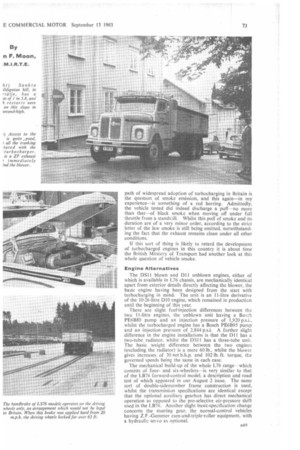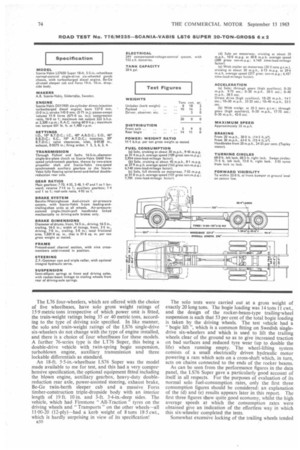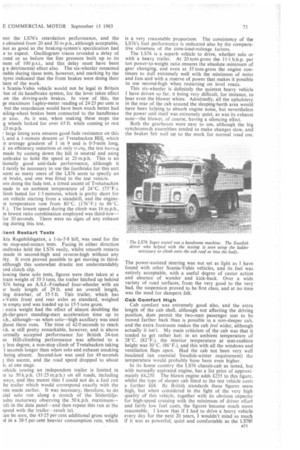TOUGH AND TURBOCHARGED
Page 74

Page 75

Page 76

Page 77

If you've noticed an error in this article please click here to report it so we can fix it.
By n F. Moon, SOME day, I hope, a British manufacturer will bring out a conventional type of normal haulage vehicle with a turbocharged diesel engine, and it could be that that time is not too far distant although there are still one or two relatively minor problems to be overcome. A country that has already gone in for turbocharging in a big way, however, is Sweden, and many of the heavy-duty road vehicles currently being produced there have turbocharged diesels.
A particularly fine example of this Swedish trend is the Scania-Vabis LS76 Super six-wheeler, which has gross solo and train weight ratings of 21 and 35 metric tons respectively (with a heavy-duty driving axle the train figure can be increased to 40 tons on good roads). The LS76 is typical of present-day Swedish heavy haulage machines and, in addition to being widely used for conventional types of haulage operation, is in considerable demand for roughduty forestry work: indeed, something like 30 per cent of all Scania-Vabis home-market sales go to the timber industry. In view of its successful use under such arduous conditions, it goes without saying that the LS76 is a tremendously robust design capable of moving large quantities of materials quickly and economically and with the minimum struggle.
It is no coincidence that the only two turbocharged goods chassis of an ordinary haulage type to have been tested by this journal have been Swedish, for there are probably more turboblown vehicles operating in Sweden than in any other European country, Swedish experience with turbos going back 11 years or so. It is encouraging to find British equipment being used on such engines, and the Scania-Vabis DS11 which powered the test vehicle has a Huddersfield-built Holset-Schwitzer blower, this make finding increasing favour with European manufacturers. A Holset crankshaft damper is used on this engine also.
One of the early fears of operators of turbocharged vehicles was that of blower life between overhauls and the resulting frequency of blower-replacement expenditure. These fears have been shown to be unfounded in the case of the Scania-Vabis engine at any rate, and a trouble-free life of over 250,000 miles can be expected from the Holset unit, this mileage, incidentally, being higher than that expected by Scania-Vabis themselves. Even when regular attention is carried out every 37,000 miles or so, it is of a relatively minor nature only.
Another objection which has been raised against turbochargers is that "there is a lag ". This means that the engine does not accelerate immediately the throttle pedal is depressed, but this can apply to normally aspirated power units and is something that I have never experienced personally. A third obstacle which appears to lie in the
path of widespread adoption of turbocharging in Britain is the question of smoke emission, and this again—in my experience—is something of a red herring. Admittedly, the vehicle tested did indeed discharge a puff—no more than that—of black smoke when moving off under full throttle from a standslill. Whilst this puff or smoke and its duration are of a very minor order, according to the strict letter of the law smoke is still being emitted, notwithstanding the fact that the exhaust remains clean under all other conditions.
If this sort of thing is likely to retard the development of turbocharged engines in this country it is about time the British Ministry of Transport had another look at this whole question of vehicle smoke.
Engine Alternatives
The DS1I blown and 011 unblown engines, either of which is available in L76 chassis, are mechanically identical apart from exterior details directly affecting the blower, the basic engine having been designed from the start with turbocharging in mind. The unit is an 11-litre derivative of the 10.26-litre DIO engine, which remained in production until the beginning of this year.
There are slight fuel-injection differences between the two 11-litre engines, the unblown unit having a Bosch PE6B80 pump and an injection pressure of 1,920 p.s.i., whilst the turbocharged engine has a Bosch PE6B95 pump and an injection pressure of 2,844 p.s.i. A further slight difference in the engine installations is that the D 11 has a two-tube radiator, whilst the DS11 has a three-tube unit. The basic weight difference between the two engine; (excluding the radiator) is a mere 60 lb.. whilst the blower gives increases of 30 net b.h.p. and 10216. ft. torque, the governed speeds being the same in each case.
The mechanical build-up of the whole L76 range —which consists of fourand six-wheelers—is very similar to that of the LB76 forward-control model, a description and road test of which appeared in our August 2 issue. The same sort of double-sidemember frame construction is used, whilst the transmission specifications are identical except that the optional auxiliary gearbox has direct mechanical operation as opposed to the pre-selective air-pressure shift used in the LB76. Another slight basic-specification change concerns the steering gear, the normal-control vehicles having Z.F.-Gemmer cam-and-triple-roller equipment, with a hydraulic servo as optional.
The L76 four-wheelers, which are offered with the choice of five wheelbases, have solo gross weight ratings of 15-9 metric tons irrespective of which power unit is fitted, the train-weight ratings being 35 or 40 metric tons, according to the type of driving axle specified. In like manner, the solo and train-weight ratings of the LS76 single-drive six-wheelers do not change with the type of engine installed, and there is a choice of four wheelbases for these models. A further 76-series type is the LT76 Super, this being a double-drive vehicle with twin-spring bogie suspension, turboblown engine, auxiliary transmission and three lockable differentials as standard.
An 18-ft. 5-5-in.-wheelbase LS76 Super was the model made available to me for test, and this had a very comprehensive specification, the optional equipment fitted including the blown engine, auxiliary gearbox, heavy-duty doublereduction rear axle, power-assisted steering, exhaust brake, Be-Ge twin-berth sleeper cab and a massive Forss timber-construction triple-dropside body with an interior length of 19 ft. 10 in. and 3-ft. 3-4-in.-deep sides. The vehicle, which had Firestone All-Traction' tyres on the driving wheels and " Transports on the other wheels-all 1100-20 (12-ply)-had a kerb weight of 8 tons 18-5 cwt., which is hardly surprising in view of its specification!
850
The solo tests were carried out at a gross weight of exactly 20 long tons. The bogie loading was 14 tons 11 cwt., and the design of the rocker-beam-type trailing-wheel suspension is such that 53 per cent of the total bogie loading is taken by the driving wheels. The test vehicle had a " bogie lift ", which is a common fitting on Swedish singledrive six-wheelers and which is used to lift the trailing wheels clear of the ground so as to give increased traction on bad surfaces and reduced tyre wear (up to double the life) when running empty. The wheel-lifting system consists of a small electrically driven hydraulic motor powering a ram which acts on a cross-shaft which, in turn, acts on chains connected to the ends of the rocker beams.
As can be seen from the performance figures in the data panel, the LS76 Super gave a particularly good account of itself in all respects. For the purposes of evaluation of its normal solo fuel-consumption rates, only the first three consumption figures should be considered: an explanation of the (d) and (e) results appears later in this report. The first three figures show quite good economy, whilst the high average speeds at which the consumption rates were obtained give an indication of the effortless way in which this six-wheeler completed the tests.
Somewhat excessive locking of the trailing wheels tended met the LS76's retardation performance, and the s obtained from 20 and 30 m.p.h., although acceptable, not as good as the braking-system's specification had e to expect. Oscillogram traces revealed a delay of :ond or so before the line pressure built up to its num of 100 p.s.i., and this delay must have been g a detrimental effect also. The six-wheeler remained ;table during these tests, however, and marking by the tyres indicated that the front brakes were doing their nare of the work.
s Scania-Vabis vehicle would not be legal in Britain -tue of its handbrake system, for the lever takes effect on the driving-axle brakes. In view of this, the ge maximum l apley-meter reading of 24-25 per cent is but the retardation would have been much better had ailing-wheel brakes been connected to the handbrake ;e also. As it was, when making these stops the g wheels locked for over 65 ft. while coming to rest 20 m.p.h.
r large lining area ensures good fade resistance on this I, and a 1-minute descent of Tvetabacken Hill, which
n average gradient of 1 in 9 and is 0-5-mile long, I an ethciency reduction at only tru4g, the test haviag made by coming down the hill in neutral and using )otbrake to hold the speed at 20 m.p.h. This is an tionally good anti-fade performance, although it I rarely be necessary to use the footbrake for this sort scent as many users of the LS76 seem to specify an Lst. brake, and one was fitted to the test vehicle.
ore doing the fade test, a timed ascent of Tvetabacken nade in an ambient temperature of 24°C. (75°F.). limb lasted for 1-5 minutes, which is pretty short for on vehicle starting from a standstill, and the engineat temperature rose from 80°C. (176°F.) to 86°C. F.). The lowest speed during the climb was 16 m.p.h., ie lowest ratio combination employed was third-lowfor 50 seconds. There were no signs of any exhaust Lng during this test.
lient Restart Tests .kta Ragnhildsgatan, a 1-in-5-8 hill, was used for the :nt stop-and-restart tests. Facing in either direction indbrake held the LS76 easily, whilst smooth restarts made in second-high and reverse-high without any LIty. It even proved possible to get moving in thirdalthough this somewhat drastic test understandably ced clutch slip.
lowing these solo tests, figures were then taken at a train weight of 35-3 tons, the trailer hitched up behind S76 being an A.S.J.-Fruehauf four-wheeler with an nbody length of 29 ft. and an overall length, ing drawbar, of 35.5 ft. This trailer, which has i-Vabis front and rear axles as standard, weighed as empty and was loaded up to 15-5 tons gross.
extra weight had the effect of almost doubling the ;h-the-gears standing-start acceleration time up to ).h., although—as when solo—high auxiliary was used ffiout these runs. The time of 42-0 seconds to reach is still pretty remarkable, however, and is above ormally accepted performance for British 24-ton es Hill-climbing performance was affected to a y less degree, a non-stop climb of Tvetabacken taking 1 seconds longer than when solo and exhaust smoking being absent. Second-low was used for 49 seconds ; this ascent, and the road speed dropped to about h. at one stage.
iehicle towing an independent trailer is limited in • to 50 k.p.h. (31-25 m.p.h.) on all roads, including ways, and this meant that I could not do a fuel run he trailer which would correspond exactly with the !sts made earlier. It was necessary, therefore, to do cial solo run along a stretch of the Stidertaljeaolm motorway observing the 50 k.p.h. maximum—. (d) in the data panel—and then repeat this run at the speed with the trailer—result (e).
:an be seen, the 43-25 per cent additional gross weight :d in a 38-5 per cent heavier consumption rate, which
is a very reasonable proportion. The consistency of the LS76's fuel performance is indicated also by the comparative closeness of the time-load-mileage factors.
The LS76 is a superb vehicle to drive, whether solo or with a heavy trailer. At 20 tons gross the 11-1 b.h.p. per ton power-to-weight ratio ensures the absolute minimum of gear changing, and even at 35 tons gross the engine continues to pull extremely well with the minimum of noise and fuss and with a reserve of power that makes it possible to use second-high when restarting on level roaas.
This six-wheeler is definitely the quietest heavy vehicle I have driven so far, it being very difficult, for instance, to hear even the blower whine. Admittedly, all the upholstery in the rear of the cab around the sleeping-berth area would have been helping to absorb engine noise, but nevertheless the power unit itself was extremely quiet, as was its exhaust note—the blower, of course, having a silencing effect. Both the gearboxes were easy to use, although the big synchromesh assemblies tended to make changes slow, and the brakes felt well up to the mark for normal road use.
The power-assisted steering was not set as light as I have found with other Scania-Vabis vehicles, and its feel was entirely acceptable, with a useful degree of castor action and absence of wander and kick-back. Over a wide variety of road surfaces, from the very good to the very bad, the suspension proved to be first class, and at no time was the need for dampers felt.
Cab Comfort High
Cab comfort was extremely good also, and the extra length of the cab shell, although not affecting the driving position, does permit the two-man passenger seat to be moved farther back than is possible in a non-sleeper cab, and the extra footroom makes the cab feel wider, although actually it isn't. My main criticism of the cab was that it tended to get rather hot: in an ambient temperature of 28°C. (82°F.), the interior temperature at seat-cushion height was 30°C. (86'F.), and this with all the windows and ventilation flaps open. Had the cab not been very well insulated (an essential Swedish-winter requirement) the temperature would probably have been even higher,
In its home country the LS76 chassis-cab as tested, but with normally aspirated engine, has a list price of approximately £4,250 The blown engine adds £255 to this figure. whilst the type of sleeper cab fitted to the test vehicle costs a further £68. By British standards these figures seem high, but when considered in the light of the very high quality of this vehicle, together with its obvious capacity for high-speed cruising with the minimum of driver effort and fairly low fuel costs, the figures become much more reasonable. I know that if I had to drive a heavy vehicle every day for the next 20 years, I wouldn't mind so much if it was as powerful, quiet and comfortable as the LS76!




















































































































